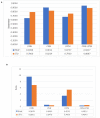An Investigation of Deep Learning Models for EEG-Based Emotion Recognition
- PMID: 33424547
- PMCID: PMC7785875
- DOI: 10.3389/fnins.2020.622759
An Investigation of Deep Learning Models for EEG-Based Emotion Recognition
Abstract
Emotion is the human brain reacting to objective things. In real life, human emotions are complex and changeable, so research into emotion recognition is of great significance in real life applications. Recently, many deep learning and machine learning methods have been widely applied in emotion recognition based on EEG signals. However, the traditional machine learning method has a major disadvantage in that the feature extraction process is usually cumbersome, which relies heavily on human experts. Then, end-to-end deep learning methods emerged as an effective method to address this disadvantage with the help of raw signal features and time-frequency spectrums. Here, we investigated the application of several deep learning models to the research field of EEG-based emotion recognition, including deep neural networks (DNN), convolutional neural networks (CNN), long short-term memory (LSTM), and a hybrid model of CNN and LSTM (CNN-LSTM). The experiments were carried on the well-known DEAP dataset. Experimental results show that the CNN and CNN-LSTM models had high classification performance in EEG-based emotion recognition, and their accurate extraction rate of RAW data reached 90.12 and 94.17%, respectively. The performance of the DNN model was not as accurate as other models, but the training speed was fast. The LSTM model was not as stable as the CNN and CNN-LSTM models. Moreover, with the same number of parameters, the training speed of the LSTM was much slower and it was difficult to achieve convergence. Additional parameter comparison experiments with other models, including epoch, learning rate, and dropout probability, were also conducted in the paper. Comparison results prove that the DNN model converged to optimal with fewer epochs and a higher learning rate. In contrast, the CNN model needed more epochs to learn. As for dropout probability, reducing the parameters by ~50% each time was appropriate.
Keywords: CNN (convolutional neural network); CNN-LSTM; DNN (deep neural network); EEG; emotion recognition.
Copyright © 2020 Zhang, Chen, Tan, Chen, Chen, Li, Yang, Su, Huang and Che.
Conflict of interest statement
The authors declare that the research was conducted in the absence of any commercial or financial relationships that could be construed as a potential conflict of interest.
Figures









Similar articles
-
Fused CNN-LSTM deep learning emotion recognition model using electroencephalography signals.Int J Neurosci. 2023 Jun;133(6):587-597. doi: 10.1080/00207454.2021.1941947. Epub 2021 Aug 27. Int J Neurosci. 2023. PMID: 34121598
-
Accelerating 3D Convolutional Neural Network with Channel Bottleneck Module for EEG-Based Emotion Recognition.Sensors (Basel). 2022 Sep 8;22(18):6813. doi: 10.3390/s22186813. Sensors (Basel). 2022. PMID: 36146160 Free PMC article.
-
Automated accurate emotion recognition system using rhythm-specific deep convolutional neural network technique with multi-channel EEG signals.Comput Biol Med. 2021 Jul;134:104428. doi: 10.1016/j.compbiomed.2021.104428. Epub 2021 May 6. Comput Biol Med. 2021. PMID: 33984749
-
Hybrid CNN-LSTM for Predicting Diabetes: A Review.Curr Diabetes Rev. 2024;20(7):e201023222410. doi: 10.2174/0115733998261151230925062430. Curr Diabetes Rev. 2024. PMID: 37867273 Review.
-
Deep Learning Techniques for Speech Emotion Recognition, from Databases to Models.Sensors (Basel). 2021 Feb 10;21(4):1249. doi: 10.3390/s21041249. Sensors (Basel). 2021. PMID: 33578714 Free PMC article. Review.
Cited by
-
A Review on Signal Processing Approaches to Reduce Calibration Time in EEG-Based Brain-Computer Interface.Front Neurosci. 2021 Aug 19;15:733546. doi: 10.3389/fnins.2021.733546. eCollection 2021. Front Neurosci. 2021. PMID: 34489636 Free PMC article. Review.
-
ERTNet: an interpretable transformer-based framework for EEG emotion recognition.Front Neurosci. 2024 Jan 17;18:1320645. doi: 10.3389/fnins.2024.1320645. eCollection 2024. Front Neurosci. 2024. PMID: 38298914 Free PMC article.
-
Emotion Recognition Using Different Sensors, Emotion Models, Methods and Datasets: A Comprehensive Review.Sensors (Basel). 2023 Feb 23;23(5):2455. doi: 10.3390/s23052455. Sensors (Basel). 2023. PMID: 36904659 Free PMC article. Review.
-
Quantification of blood flow index in diffuse correlation spectroscopy using a robust deep learning method.J Biomed Opt. 2024 Jan;29(1):015004. doi: 10.1117/1.JBO.29.1.015004. Epub 2024 Jan 27. J Biomed Opt. 2024. PMID: 38283935 Free PMC article.
-
The applied principles of EEG analysis methods in neuroscience and clinical neurology.Mil Med Res. 2023 Dec 19;10(1):67. doi: 10.1186/s40779-023-00502-7. Mil Med Res. 2023. PMID: 38115158 Free PMC article. Review.
References
-
- Alhagry S., Aly A., El-Khoribi R. A. (2017). Emotion recognition based on EEG using LSTM recurrent neural network. Int. J. Adv. Comput. Sci. Appl. 8, 355–358. 10.14569/IJACSA.2017.081046 - DOI
-
- Chen J. X., Zhang P. W., Mao Z. J., Huang Y. F., Jiang D. M., Zhang Y. N. (2019). Accurate EEG-based emotion recognition on combined features using deep convolutional neural networks. IEEE Access. IEEE 7, 44317–44328. 10.1109/ACCESS.2019.2908285 - DOI
-
- Cheng C., Parhi K. K. (2020). Fast 2D convolution algorithms for convolutional neural networks. IEEE Trans. Circuits Syst. I Regular Pap. 67, 1678–1691. 10.1109/TCSI.2020.2964748 - DOI
-
- de Boer P. T., Kroese D. P., Mannor S., Rubinstein R. Y. (2005). A tutorial on the cross-entropy method. Ann. Operat. Res. 134, 19–67. 10.1007/s10479-005-5724-z - DOI
-
- deCarlo L. T. (1997). On the meaning and use of kurtosis. Psychol. Methods 2, 292–307. 10.1037/1082-989X.2.3.292 - DOI
LinkOut - more resources
Full Text Sources
Research Materials

